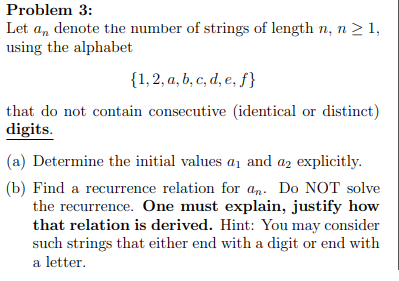Let an denote the number of strings of length n, n ≥ 1, using the alphabet {1, 2, a, b, c, d, e, f} that do not contain consecutive (identical or distinct) digits. (a) Determine the initial values a1 and a2 explicitly. (b) Find a recurrence relation for an. Do NOT solve the recurrence. One must explain, justify how that relation is derived. Hint: You may consider such strings that either end with a digit or end with
Let an denote the number of strings of length n, n ≥ 1, using the alphabet {1, 2, a, b, c, d, e, f} that do not contain consecutive (identical or distinct) digits. (a) Determine the initial values a1 and a2 explicitly. (b) Find a recurrence relation for an. Do NOT solve the recurrence. One must explain, justify how that relation is derived. Hint: You may consider such strings that either end with a digit or end with
Linear Algebra: A Modern Introduction
4th Edition
ISBN:9781285463247
Author:David Poole
Publisher:David Poole
Chapter4: Eigenvalues And Eigenvectors
Section4.6: Applications And The Perron-frobenius Theorem
Problem 57EQ
Related questions
Question
Let an denote the number of strings of length n, n ≥ 1,
using the alphabet
{1, 2, a, b, c, d, e, f}
that do not contain consecutive (identical or distinct)
digits.
(a) Determine the initial values a1 and a2 explicitly.
(b) Find a recurrence relation for an. Do NOT solve
the recurrence. One must explain, justify how
that relation is derived. Hint: You may consider
such strings that either end with a digit or end with
a letter.

Transcribed Image Text:Problem 3:
Let a, denote the number of strings of length n, n > 1,
using the alphabet
{1,2, a, b, c, d, e, ƒ}
that do not contain consecutive (identical or distinct)
digits.
(a) Determine the initial values a1 and az explicitly.
(b) Find a recurrence relation for an. Do NOT solve
the recurrence. One must explain, justify how
that relation is derived. Hint: You may consider
such strings that either end with a digit or end with
a letter.
Expert Solution
This question has been solved!
Explore an expertly crafted, step-by-step solution for a thorough understanding of key concepts.
Step by step
Solved in 2 steps

Knowledge Booster
Learn more about
Need a deep-dive on the concept behind this application? Look no further. Learn more about this topic, advanced-math and related others by exploring similar questions and additional content below.Recommended textbooks for you

Linear Algebra: A Modern Introduction
Algebra
ISBN:
9781285463247
Author:
David Poole
Publisher:
Cengage Learning

Algebra for College Students
Algebra
ISBN:
9781285195780
Author:
Jerome E. Kaufmann, Karen L. Schwitters
Publisher:
Cengage Learning

Linear Algebra: A Modern Introduction
Algebra
ISBN:
9781285463247
Author:
David Poole
Publisher:
Cengage Learning

Algebra for College Students
Algebra
ISBN:
9781285195780
Author:
Jerome E. Kaufmann, Karen L. Schwitters
Publisher:
Cengage Learning